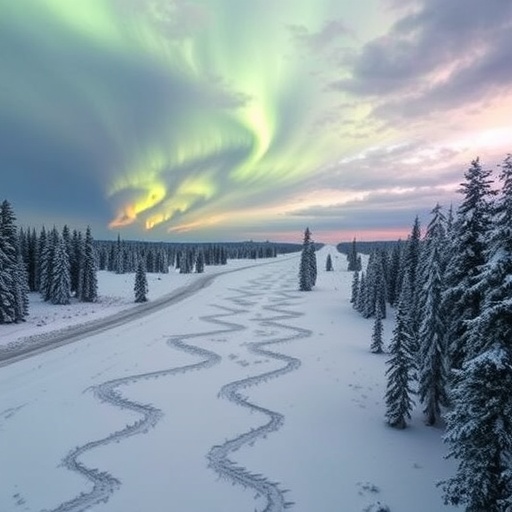The Arctic, often hailed as the planet’s most sensitive climate indicator, is undergoing profound transformations that are reshaping its entire environmental system. An international cohort of climate scientists has meticulously analyzed extensive historical climatological data and combined it with future projections from the Coupled Model Intercomparison Project Phase 6 (CMIP6). Their findings reveal a critical “pushing and triggering” mechanism driving the Arctic’s climate toward a fundamentally new state. This transition portends a future marked by a notable escalation in the frequency and intensity of extreme weather and climate events, affecting the atmosphere, ocean, and cryosphere alike throughout this century.
Temperature increases in the Arctic surpass global averages by more than threefold, a phenomenon widely recognized as Arctic amplification. Despite this well-documented warming trend, the complex interdependencies linking atmospheric dynamics, oceanic conditions, and sea ice variability in the context of extreme events have been largely underexplored—until now. This comprehensive review led by Dr. Xiangdong Zhang from North Carolina State University synthesizes observational records and state-of-the-art climate modeling to unravel the intricate relationships shaping Arctic extremes.
The research team’s investigation covered temperature and extreme event records dating from the 20th century through projections extending to 2100. They observed that since 2000, events such as atmospheric and oceanic heatwaves, heavy precipitation episodes, accelerated sea ice retreat, and substantial ice sheet melting have shifted from episodic to recurring phenomena. These occurrences not only increased in intensity but also in baseline frequency, signifying a systemic transformation in Arctic climatic norms. CMIP6 model projections indicate these trends will intensify with ongoing anthropogenic forcing.
Conventional understanding suggests Arctic warming proceeds incrementally and uniformly; however, the study challenges this notion by demonstrating nonlinear changes propagated through complex feedbacks within the atmosphere-ocean-ice system. The “pushing” corresponds to sustained long-term warming influences, while the “triggering” arises from internally generated variability such as synoptic cyclones and blocking high-pressure systems. Together, these processes create tipping points that abruptly shift the baseline Arctic climate state.
Since the turn of the millennium, the researchers identify a palpable step change in the Arctic system—this new baseline is characterized by enhanced poleward heat and moisture transport via atmospheric circulation, compounded by oceanic currents delivering warmer waters into polar zones. Simultaneously, persistent cyclonic activities and stationary atmospheric pressure anomalies obstruct the progression of weather systems, intensifying regional heating and sea ice degradation. These dynamics synergistically amplify the warming feedback loop, escalating the climate system’s propensity for extreme events.
Quantitative analyses reveal that the likelihood of experiencing atmospheric heatwaves in the Arctic has surged by approximately 20% since 2000. Concurrently, warm events affecting the Atlantic ocean layers have increased by a staggering 76%, while episodes of sea ice loss have risen by 83%. Greenland’s Ice Sheet, a vital component of global sea-level regulation, has seen its melt extent swell by nearly 68%. Such dramatic increases underscore the Arctic’s transition into an era where previously rare extremes now define baseline environmental variability.
Dr. Zhang emphasizes that these changes represent more than incremental shifts; they symbolize a fundamental reconfiguration of the region’s climate architecture. This new dynamical regime significantly influences mid-latitude weather patterns through teleconnections, potentially resulting in broader climatic disruptions far beyond the Arctic Circle. Understanding the Arctic’s nonlinear responses to both external forcing and intrinsic variability is therefore crucial for global climate forecasting.
Forthcoming decades likely will see the Arctic continue on this trajectory, with ice-free summers becoming a tangible reality by mid-century under current emission trajectories. This loss of perennial sea ice not only disrupts regional ecosystems but also feeds back into the global heat balance, accelerating warming worldwide. The study calls for enhanced observational networks and refined high-resolution climate models to capture the multifaceted multiscale drivers underlying these rapid transitions.
The interdisciplinary research team, spanning continents and institutions, underscores the necessity of integrating atmospheric science, oceanography, cryospheric physics, and climate modeling to robustly characterize Arctic extremes. Their collective efforts highlight the urgency of advancing physical process understanding, especially in mapping the interplay between large-scale circulation patterns and localized feedback mechanisms inherent to the Arctic environment.
Ultimately, this synthesis presents an alarming picture of a climate system crossing thresholds into precarious new territory. The Arctic’s shifting baseline states and escalating extremes demand immediate attention not only for polar stakeholders but also for global climate resilience strategies. Continued investment in Arctic science and international collaboration remains paramount to predict and mitigate cascading impacts associated with this pivotal environmental transformation.
Subject of Research: Not applicable
Article Title: Weather and climate extremes in a changing Arctic
News Publication Date: 21-Oct-2025
Web References:
https://www.nature.com/articles/s43017-025-00724-4
References:
Xiangdong Zhang et al., “Weather and climate extremes in a changing Arctic,” Nature Reviews Earth & Environment, 21 October 2025. DOI: 10.1038/s43017-025-00724-4
Keywords: Climate change effects; Arctic ice; Atmospheric science




